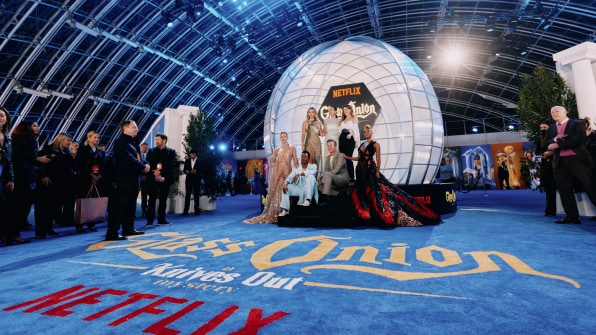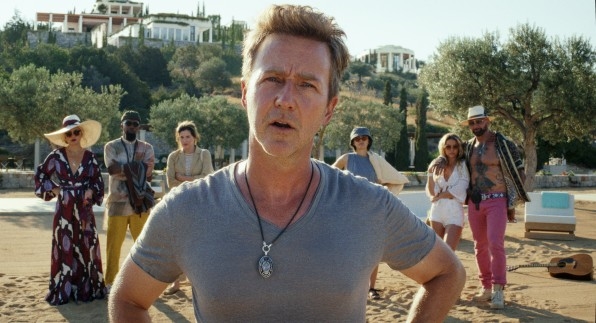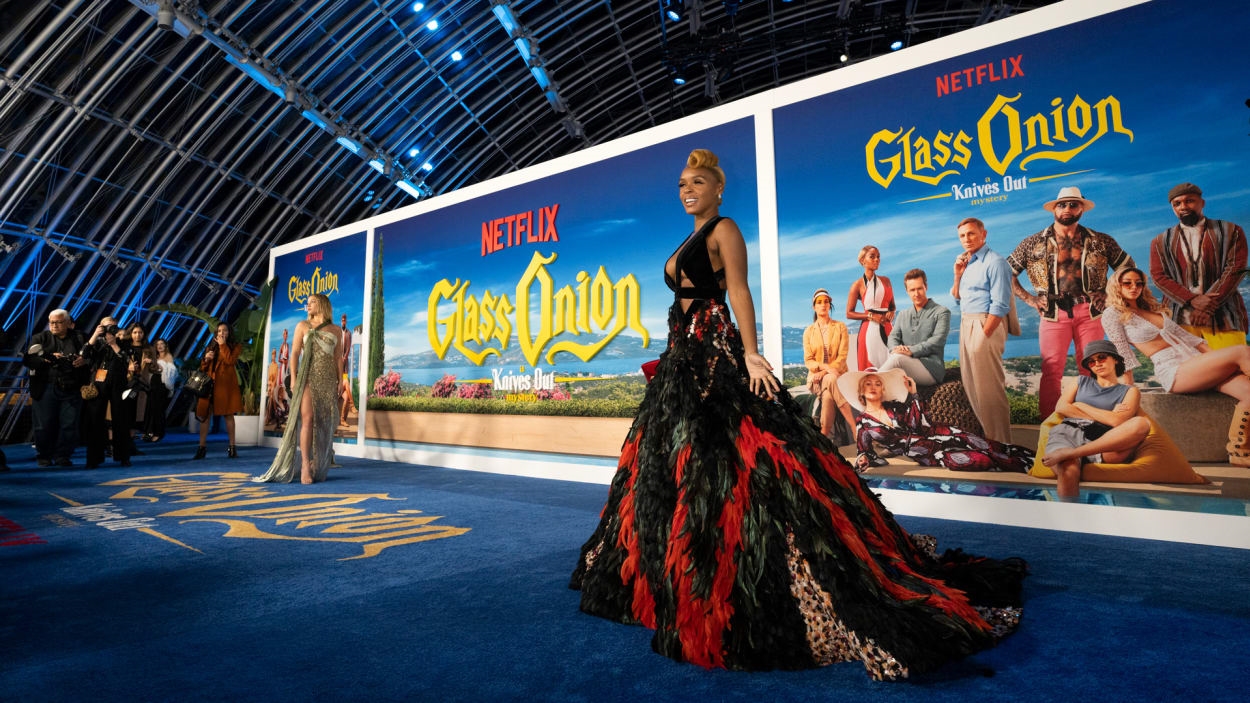Netflix’s strange ‘Glass Onion: Knives Out 2’ release strategy just might work
On Wednesday, November 23, the cumbersomely titled Glass Onion: A Knives Out Mystery will become the first Netflix original to play in the world’s largest exhibitors’ theaters. Far from a traditional release, whatever that even means these days, its limited run will last just one week, followed by a 23-day wait until the film shows up under Netflix subscribers’ Christmas trees. It’s an experimental rollout, light on precedent and heavy on uncertainties.
What the experiment means for the future of moviegoing, though, is a puzzle box even Daniel Craig’s Benoit Blanc might not be able to sleuth his way out of. Let’s take a crack at it anyway.
Netflix goes to the movies
The sequel to Rian Johnson’s 2019 surprise smash Knives Out marks an end to, or at least the complicating of, a nearly decade-long cinematic stalemate between the streamer and the largest theater chains. After coming out of the original content-gate hot in 2013 with Emmy-winning hits like House of Cards, the company turned its attention to films. The first was 2015’s Beasts of No Nation, a prestige sociopolitical drama starring Idris Elba and directed by Cary Joji Fukunaga, clearly intended to replicate the instant award success Netflix had just enjoyed in the TV space. When the company announced its plans to debut in theaters the same day as streaming, though, exhibitors balked.
Both sides made good points. If Netflix’s zillion subscribers could just as easily stay home to watch the film, it might broadly play to half-empty theaters. But if it was showing in too many theaters, and beyond the seven days it takes to qualify for awards, potential subscribers might not feel sufficiently enticed into signing on. (The desire to avoid splashing out on a theatrical marketing campaign, which is usually 50% of a film’s actual production budget, likely also helped shape the streamer’s thinking here) Ultimately, the four largest chains—AMC, Carmike, Cinemark, and Regal—opted out. Netflix circumvented them with independent theaters, but Beasts of No Nation subsequently eked out only $90,000 at the box office and was snubbed by the Oscars, despite its critical darling status.

Neither side budged much in the years that followed. Netflix went on to spend untold billions building out its film portfolio with Adam Sandler comedies, glossy YA romps, and mega-budget action flicks starring Ryan Reynolds and a Chris or two, alongside some high-pedigree awards fare, but it never once made enough concessions to secure a wide theatrical play. Meanwhile, early rival Amazon Studios scored a Best Picture nomination (and some other big wins) with 2016’s Manchester-by-the-Sea—by observing the traditional theatrical window. Sticking to its guns is probably at least partly why Netflix didn’t land a Best Picture nomination until Alfonso Cuaron’s elegant epic Roma, which played in indie theaters for three weeks in 2018 and fetched three Oscars the next year, including Best Director. “They’ve disconnected people from movies in a way,” Netflix chief content officer Ted Sarandos said of theatrical windows at the time. “I don’t think it’s very consumer-friendly that consumers who don’t happen to live near a theater are waiting six months, eight months to see a movie.”
On the eve of the award ceremony, no less a Hollywood establishment figure than Steven Spielberg shaded the streamer for refusing to play by theatrical rules, telling a reporter for ITV: “I don’t believe that films that are just given token qualifications, in a couple of theaters for less than a week, should qualify for the Academy Awards.”
Ouch.
The impasse seemed on its way toward a resolution when Netflix offered exclusive rights for 45 days to its biggest 2019 offering: Martin Scorsese’s gangster eulogy, The Irishman. The chains weren’t interested, though.
At the time, 45 days was seen as too short. Then the pandemic changed everything.
The incredible shrinking window
It’s hard to imagine now, but after Who Framed Roger Rabbit? became a seismic hit in June 1988, fans had to wait until October to watch it on home video. Even more amazing—they had to wait until October the following year.
That particular release may have been an outlier, but it was indicative of an era when movies generally took at least six months to migrate from the box office to Blockbuster. “I’ll just wait for it to come out on video” meant one might be left hanging for a very long time, and the potential for regret added to the value of the moviegoing experience. In the late-90s and early aughts, though, the golden age of DVD sales halved the theatrical window down to three months, where it remained as industry standard for a long time.
Studios had already started chipping away at that standard well before the pandemic, much to theaters’ chagrin. In 2015, for instance, Paramount made a deal with AMC and Cineplex to put out Paranormal Activity: The Ghost Dimension and Scouts Guide To The Zombie Apocalypse on PVOD just 17 days (three weekends) after each film dipped below 300 theaters, and the deal so offended the other major chains—Regal, Cinemark, and Carmike—that they refused to screen both films, dooming them to soft box office. It was only when theaters began to shutter in the early months of 2020, though, and homebound viewers craved new premium content, that the sanctity of a months-long theatrical window began to seem not-so-sacred at all.
During that strange time, there was a lot of talk about “shattering” the window—most famously when Warner Bros announced its entire 2021 slate would debut day and date on its streaming service, HBO Max. In hindsight, though, the window appears to have merely sustained some dings and minor cracks. As the peak of the pandemic waned, the public appetite for going to the movies resumed with a vengeance, signaling a sunnier outlook for the future of theatrical. The standard window that studios seemed to settle on for the moment was—the once heretical 45 days—although some streamers have since adopted a case-by-case outlook, and world-thumping titles like Spider-Man: No Way Home and Top Gun: Maverick still play for a full three months.
As exhibitors’ fortunes rose this past year, though, Netflix, who’d been ascendant through the earlier COVID era, suddenly found itself in a position to consider evolving its business model.
Sharpening the ‘Knives’
Just one year after dropping a whopping $465 million on two Knives Out sequels in the spring of 2021, Netflix endured its largest quarterly subscriber loss in over a decade. Its stock has been hammered down 56% in the last 12 months. The company responded by tightening its belt, with around 450 layoffs, promising a crackdown on password-sharing, and the (reluctant) introduction of a cheaper, ad-supported subscription tier. The stage was set for trying something new.
At last April’s CinemaCon, the world’s largest annual gathering of theatrical players, some interesting rumors emerged. Senior executives from Netflix reportedly discussed floating a trial balloon movie in wide release with a 45-day window before the end of the year. The two prime candidates were said to be Alejandro González Iñárritu’s Bardo and the sequel to Knives Out. It wasn’t until Glass Onion: A Knives Out Mystery wowed critics at the Toronto International Film Festival in September that Netflix officially made a deal with major exhibitors. It probably still would have happened even had the response been less universally glowing.

Glass Onion is an ideal candidate to be Netflix’s coal mine canary with wider releases for many reasons. It’s a relatively cheaply made, memeable four-quadrant film from a burgeoning franchise with global appeal. Movies with a $40 million budget generally do not make $311 million worldwide, as Knives Out did, nor do they tend to multiply their five-day opening weekend box office four times over by the end of their run. While the new film may get an Oscar nomination or two if early buzz is any indicator, it’s not the kind of Oscar-bait movie that Netflix typically spends millions to market to award voters. Essentially, it’s a unicorn.
“This is arguably the largest property that Netflix has invested in, and they have so much hanging in the balance with it,” says David Herrin, founder of prerelease data-tracking outfit The Quorum. “My personal opinion is that Netflix is beginning to realize they need to incorporate a larger theatrical component to their movies, and that they’re trying to gently expand their footprint and extend an olive branch to theaters with this film, all in a play to build relationships for that day in the next year or two when they do some serious theatrical releases.”
Considering that Glass Onion seems like such a slam dunk for Netflix’s first major theatrical play, though, the terms of the release itself are rather odd.
Let the experiment begin
Billed by Netflix as a sneak preview event, the Knives Out sequel joins a crowded Thanksgiving marketplace that includes Disney’s next animated feature and the latest from noted Netflix critic Steven Spielberg. According to The Quorum, awareness around Glass Onion has remained curiously low—possibly due to its not having the more straightforward title Knives Out2—but Thanksgiving week is primetime for “let’s just see what’s playing” style moviegoing. While the original film had plenty of time to build steam as a word-of-mouth hit, though, its sequel will only have one week. Anybody who hears breathless endorsements from friends in the days afterward will have nothing to do with their anticipation except . . . not cancel Netflix until at least after Christmas. It’s a shrewd move on the streamer’s part. It stands to inherit all the buzz generated by Glass Onion’s brief time in theaters.
It’s also curious, considering the milestone of Netflix finally striking a deal with the three largest exhibitors, that the Knives Out sequel will only play in about 600 theaters in the U.S. and Canada—just 100 more than The Irishman and Roma. (It will also screen theatrically overseas, in several countries.) Why not blow the doors off this thing if all the major chains are involved? For that matter, why not finally bend on Netflix’s long-standing insistence on not revealing box-office figures? If ever there was a time to do so, this is it.

Contrarians aside, most people want to see the movie everybody else is seeing and talking about. A hit’s very hitness confers upon it an extra layer of interest, and much more so when it’s conveyed by a third party who isn’t using internal metrics to claim that, say, Red Notice had the biggest opening day ever. A headline reporting how much Glass Onion overperformed on its opening day in theaters could potentially reel in more ticket-buyers than the expensive NFL game trailers Netflix appears to have purchased. Still, the company has so far signaled that it will continue keeping the numbers quiet this time out.
So, how will we know if Glass Onion is a hit in theaters?
“The truth is: We won’t know,” says Herrin.
Perhaps the only way we’ll be able to tell is by tracking whether Netflix continues gradually ramping up with wider releases in the future. The problem, however, is that the company potentially stands to become a victim of its own success. If releasing priority titles in theaters soon becomes a more common practice, the films Netflix doesn’t put out that way will suddenly seem more than ever like TV movies or straight-to-DVD fare—demonstrably lesser, in some way. It’s hard to imagine top talent continuing to make deals with Netflix without demanding that their films see some (dimmed) light of day inside a theater. Whatever revenue Netflix brings in from putting more films in theaters might be negated by the cost of mounting so many theatrical marketing activations and follow-up Oscar campaigns, not to mention the loss of some mid-tier movies from marquee names who don’t want their projects to be seen as inferior product.
But considering that Apple TV+ earlier this year became the first streamer to score an actual Best Picture Oscar win, and then followed it up with an innovative deal for its Brad Pitt Formula One racing film to receive a wide release with a “meaningful” window, the future of streaming seems increasingly theatrical. There’s no mystery there.
(68)



